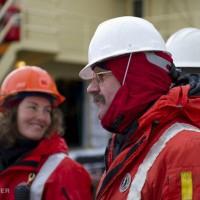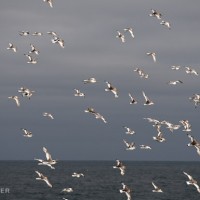
Mooring Deployment Time-lapse Video
This time lapse video shows the mooring being deployed from the back deck. It represents two hours of real time.
Read more
This time lapse video shows the mooring being deployed from the back deck. It represents two hours of real time.
Read more
After three days of overcast skies and whitecaps, today the wind settled and the sky cleared. Sun warmed the observation deck on the bow, and stiff-winged snow petrels flittered among the waves as if impatient for the wind to return. We had steamed south about 120 miles to get some more information from an interesting […]
Read more
We love getting questions from people reading along on our blog or in classrooms. Yesterday we heard from Shiquan at Monument School, who asked why iron makes plants grow. That’s a great question that gets right to the heart of biological oceanography, so let’s take a day and explore the answer. If you remember from […]
Read more
Today’s story starts yesterday evening, and it features valuable items lost at the bottom of the sea, a midnight rescue plan sketched out on a napkin, a grappling hook as tall as a person, and a creature that looks like a space flower. We had come to Cape Adare to help Bruce Huber of Lamont-Doherty […]
Read more
We heard that in New Jersey it’s been snowy and very cold. So be proud! You’re in a place that’s colder than Antarctica right now. After four days of work in the waters of the central Ross Sea, the Palmer headed northwest toward the opening of the Southern Ocean. The northernmost end is called Cape […]
Read more
Today I toured around the work stations of each of the scientists studying Modified Circumpolar Deep Water: Drs. Josh Kohut, Chris Measures, Phoebe Lam, Angelicque White, Allen Milligan, and Adam Kustka. They’re all here because they have a hypothesis about how MCDW contributes to the summer blooms of phytoplankton that provide so much food to […]
Read more
We’ve talked a lot about Modified Circumpolar Deep Water recently. It’s the water that our gliders are looking for, and our scientists think the nutrients it carries cause the great blooms of food during the Ross Sea’s summers. Let’s take a day to get to know it. MCDW starts out in water 400 meters (1320 […]
Read more
In walkie-talkie etiquette, you call to the person you want to talk to, then identify yourself. So when ‘Glider Base, this is Zodiac’ comes over the radio, it means that someone in a little inflatable rubber boat (called a zodiac) wants to talk to the person who is running the gliders. Six of us were […]
Read more
Last night, Captain Yousri Maghrabi steered the Palmer toward Station A, at 76.5 degrees south, 170 degrees east. It’s just a patch of open water about 40 miles northeast of Ross Island, but oceanographers have been measuring water here since the mid-1990s. When we got there, the only land left visible were Ross and Beaufort […]
Read more